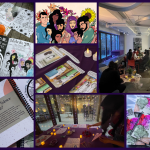This week, several members of The Women’s Foundation staff are participating in the Food Stamp Challenge, an exercise organized by D.C. Hunger Solutions that educates the public and raises awareness of the benefits of food stamps and the challenges recipients face while eating on a very limited budget. The staff will be sharing their experiences on this blog.
After a fairly uneventful first day of the Food Stamp Challenge, I woke up a little hungry on day two. Yesterday started off with a banana and water for breakfast. That’s actually more than I normally have since I’m not a breakfast person, but I figured I should get something into my system to help me get through the day, especially since I didn’t have my morning caffeine!
For lunch I had a very small salad that consisted of lettuce and chickpeas. I find that I’m rationing my food a bit—eyeballing my lettuce to try to determine just how many salads and of what size I can make between now and October 15th. I have two tomatoes, but I didn’t want to use an entire tomato on the first day, so I opted to save it for later.
I cooked brown rice and a veggie stir fry of broccoli, carrots, and green beans for dinner. I also added a small salad (this time with tomatoes). I’ll admit I did have a glass of wine with dinner! This was not part of my budget, and in fact you cannot use food stamps to purchase alcohol.
What was most interesting about the first day was the conversation that the staff of The Women’s Foundation engaged in during our staff meeting. Four of us are undertaking the challenge—two of us on our own, and the other two with their families.
One staff member felt hungry earlier in the morning and had already eaten half of her lunch, despite the fact that she normally doesn’t eat breakfast. She thought there was a psychological aspect to it because her day hadn’t started any differently from a normal day for her.
Another staff member was excited about the meals she planned because she was cooking food from her native country of Ghana. She didn’t feel as if she was making a huge sacrifice – the meals felt like comfort food to her – although she was very aware of how expensive certain things were when she shopped (like eggs for example), and she was hungry later in the day.
Another staff member felt it was much easier to do the challenge with multiple people because she had more money to spend ($30 per person) and could buy certain things in bulk. I was jealous of the eight pounds of apples she bought for $8!
Each of us also reflected on the “luxuries” we had as we did our shopping, the first being transportation to easily get us to the grocery store at whatever time of the day of night we needed to go. Additionally, the four of us live in Northern Virginia where we have access to a multitude of grocery stores and markets. One staff person shopped around for the best deals and as a result ended up shopping at several different stores.
It was a stark reminder that many living in our region do not have these “luxuries.” According to new data from DC Kids Count, one-third of DC neighborhood clusters do not have a grocery store. Of these neighborhoods, nearly half have child poverty rates above 50 percent. So where do these families shop, and what are they buying?
Jennifer Lockwood-Shabat is vice president of The Women’s Foundation.


